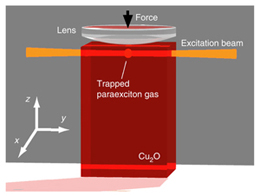Research Abstract
サブケルビン温度における励起子のボースアインシュタイン凝縮体への転移と緩和爆発
今回我々は、励起子をサブケルビン温度に冷却し、空間的に閉じ込めることで、BECの臨界数を実現した。
Transition to a BoseEinstein condensate and relaxation explosion of excitons at sub-Kelvin temperatures
2011年5月31日 Nature Communications 2 : 328 doi: 10.1038/ncomms1335

量子多体系に生じる準粒子は、現代物理学のさまざまな問題において重要な役割を担っている。半導体における励起子のボースアインシュタイン凝縮(BEC)は、多体電子中の光励起された準粒子において、予想されているが観測されていない量子統計現象の1つである。特に、亜酸化銅のパラ励起子は、輻射場との結合が切れているので、BECによって生じるコヒーレント集団が純粋に物質波的になるため、数十年来研究されてきた。しかし、2体非弾性衝突過程に起因して、超流動液体ヘリウム4温度ではBECの実現が困難なことがわかっている。したがって、励起子温度をさらに下げて、より低い臨界密度に調整する必要がある。今回我々は、励起子をサブケルビン温度に冷却し、空間的に閉じ込めることで、BECの臨界数を実現した。我々は、水素原子において議論されてきた緩和爆発として、BECが現れることを示す。この結果は、希薄な励起子が純粋にボソン的であり、BECが実際に生じていることを示している。
- 東京大学大学院理学系研究科物理学専攻
- 東京大学大学院工学系研究科物理工学専攻
- 独立行政法人 科学技術振興機構
-
東京大学大学院工学系研究科附属光量子科学研究センター
*ハーバード大学(米国)
Quasiparticles in quantum many-body systems have essential roles in modern physical problems. Bose–Einstein condensation (BEC) of excitons in semiconductors is one of the unobserved quantum statistical phenomena predicted in the photoexcited quasiparticles in many-body electrons. In particular, para-excitons in cuprous oxide have been studied for decades because the decoupling from the radiation field makes the coherent ensemble a purely matter-like wave. However, BEC has turned out to be hard to realize at superfluid liquid helium-4 temperatures due to a two-body inelastic collision process. It is therefore essential to set a lower critical density by further lowering the exciton temperature. Here we cool excitons to sub-Kelvin temperature and spatially confine them to realize the critical number for BEC. We show that BEC manifests itself as a relaxation explosion as has been discussed in atomic hydrogen. The results indicate that dilute excitons are purely bosonic and BEC indeed occurs.

